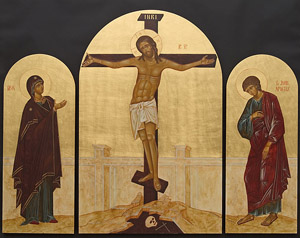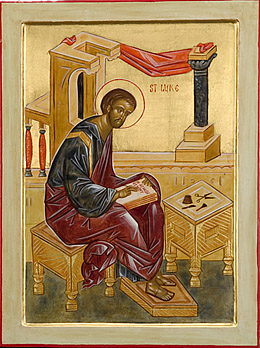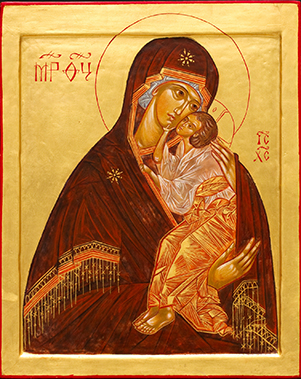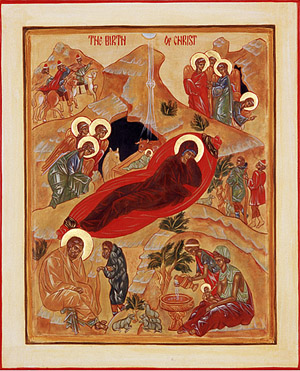Icons are prayer made visible
 The Icon forms the iconographer. For the iconographer, process is more important than product. Traditionally, an iconographer fasts and prays before beginning to write an Icon. The iconographer strives to live an anonymous life hidden in Christ and never signs the Icon with her own name. She may sign it "written through the hand of..." to acknowledge the presence of the Spirit moving through her and using her as a tool.
The Icon forms the iconographer. For the iconographer, process is more important than product. Traditionally, an iconographer fasts and prays before beginning to write an Icon. The iconographer strives to live an anonymous life hidden in Christ and never signs the Icon with her own name. She may sign it "written through the hand of..." to acknowledge the presence of the Spirit moving through her and using her as a tool.
Icons are prayer made visible. In addition to being a reflection of the prayer of the iconographer and of the Christian tradition. Through the use of the natural materials (wood, gold, egg, gesso, and mineral pigments) used to write an icon, these images speak through line, color, and form of the world that is both familiar and yet unknown. Imbued with calm, silence, and peace, they proclaim the Word of God and act as a still point in a world of noise and confusion. icons offer a window of contemplation into the sublime nature of God, a nature the lives as a spark within each of us.
Icons of the Savior

The representation of Christ the Savior can be rendered in many different ways, from the face itself (Face of Christ Not Made by Human Hands) to the full-standing figure of the Savior. When showing more than just the face, the figure is always shown wearing a tunic in a variation of red or purple. This represents the color of humanity. The band of gold over the shoulder represents His authority. The tunic is covered with a dark blue cloak, the color of transcendence.
On the Cruciform halo appear the Greek letters which spell the name of Yahweh, "He Who Is."
The transparency of God shining through the spiritual person is intimately connected with the "presence" contained in the icon, which justifies its veneration. The icon attempts to create a balance between the expression of Christ's sovereignty as divine Judge and His benevolent gaze, which penetrates the recesses of the heart.
Icon of the Holy Trinity
![]() This translation of the Icon of the Holy Trinity is among the very greatest of the icons of the undivided Church. St. Andre Rublev painted the original icon of the Trinity in this particular mode between 1408 and 1425 for the monastery of the Trinity and St. Sergis. The purpose was to offer a way to keep hearts centered in god during a time of war, calamity and political unrest. The icon was not painted as a lovely decoration for a church, but as a holy PLACE to enter and to say within.
This translation of the Icon of the Holy Trinity is among the very greatest of the icons of the undivided Church. St. Andre Rublev painted the original icon of the Trinity in this particular mode between 1408 and 1425 for the monastery of the Trinity and St. Sergis. The purpose was to offer a way to keep hearts centered in god during a time of war, calamity and political unrest. The icon was not painted as a lovely decoration for a church, but as a holy PLACE to enter and to say within.
This icon is a gentle invitation to enter into this House of God's Love and to participate in intimate conversation — to participate in a relationship. Through the Trinity, we are invited to enter into the mystery of Divine Love and to allow ourselves to become the objects of the Benevolent gaze of God. The image of the Trinity, living the the House of God's Love, not only provides protection against the ear and distress of our own time, but also reveals the inner beauty of God
The image of the Trinity as three angels comes from the Book of Genesis in the Old Testament. The icon is written as the Hospitality of Abraham and acts as a bridge between the Old Testament and the New Testament. The angelic appearance — angels are shown with wings to indicate their divine nature — is the pre-figuration of the divine mission by which God sends His only Son to give us life through the Spirit. There are many different versions of this Icon.
Icons of the Angels and Saints
 Icons of the Angels and the Saints are among the most cherished of all iconographic images. They are often written in honor of a particular person or for a particular community. In the complete participation of the Saints in the Incarnation of Christ, humanity has been fully realized. In the devotion and beauty of the Angels, a model of the true and just servant is presented to all of creation.
Icons of the Angels and the Saints are among the most cherished of all iconographic images. They are often written in honor of a particular person or for a particular community. In the complete participation of the Saints in the Incarnation of Christ, humanity has been fully realized. In the devotion and beauty of the Angels, a model of the true and just servant is presented to all of creation.
The Christian Church teaches the Angels are not simply 'good' spirits or embodiments of some principle of goodness and truth, but moral, rational beings capable of choosing for and against God. For this reason, it is possible speak of the holiness of Angels and to include them in the ranks of the Saints.
The lightweight wings of the Angels symbolize the absence of any earthly attractions, a pure and total thrust toward the heights, devoid of any heaviness. Their luminous and incandescent garments signify the divine: that power of enlightenment which the celestial intelligences derive from their being assigned to dwell in heaven, the very domain of light. So too, the Saints are portrayed with bodies that have lost a purely natural look. Pink skin gives way to glowing ochre, yellow, red. Heads are always turned toward the viewer. Their eyes are large and open, their foreheads, large and filled with wisdom. Their noses are long and noble' their mouths are always closed in silent meditation.
Icons of the Mother of God
 Numerous forms of icons of the Mother of God (Theotokos) have been written over the centuries. They are among the most popular of all icons and convey the great beauty and delicate compassion. One type, the Hodigitria form, portrays the Christ Child seated upright on His Mother's arm. His gold-woven garment is the royal and priestly dress. The Mother, robed in a mantel of deep red bordered in gold, presents the Child to all of humanity. Her facial expression is serious, full of regal serenity; her gaze is aimed directly at the viewer.
Numerous forms of icons of the Mother of God (Theotokos) have been written over the centuries. They are among the most popular of all icons and convey the great beauty and delicate compassion. One type, the Hodigitria form, portrays the Christ Child seated upright on His Mother's arm. His gold-woven garment is the royal and priestly dress. The Mother, robed in a mantel of deep red bordered in gold, presents the Child to all of humanity. Her facial expression is serious, full of regal serenity; her gaze is aimed directly at the viewer.
The icon of the Mother of God of Tenderness in immensely beautiful. It portrays the Theotokos with her cheek against that of her Son in love and devotion. her gaze, at once far-sighted and turned to an interior vision, is the best expression of the mystery of Mary. The icon of the Mother of God of Sorrows is deeply moving. The Theotokos has just witnessed the worst imaginable to any mother yet she is still full of love and hope and strength and courage.
Icons of the Feast Days
 The icons of the Feast Days (festal Icons) bring to life the various key Feast Days of the Church's calendar. Such events include the Annunciation, the Nativity, the Crucifixion, the Resurrection, Pentecost. In the icon of the Nativity, the very essence of the event is disclosed: the fact of the Incarnation of God as the visible testimony of a fundamental truth of the Christian faith. Both the divine and the human are described in the icon. All of creation takes part in the events around the Divine Child. Time itself is suspended, and everything happens all at once.
The icons of the Feast Days (festal Icons) bring to life the various key Feast Days of the Church's calendar. Such events include the Annunciation, the Nativity, the Crucifixion, the Resurrection, Pentecost. In the icon of the Nativity, the very essence of the event is disclosed: the fact of the Incarnation of God as the visible testimony of a fundamental truth of the Christian faith. Both the divine and the human are described in the icon. All of creation takes part in the events around the Divine Child. Time itself is suspended, and everything happens all at once.
All of creation is represented rendering service or giving thanks. The Angels bring their glory and their song. The Star of Life, with its three points of light representing the Trinity, is seen as a messenger from the Cosmos. The Wise Men (Magi), men of learning, symbolize the acceptance of men and women of science and learning to the mystery of the Divine; they represent the pagan world, as Christ came to the entire world, to all people in all circumstances. Mary represents all of humanity. In giving birth, she is affirmed in her place as the Mother of God. She occupies a prominent place as the mother of the renewal of humanity. Also in the icon are mountains, shepherds, midwives, the tempter. And Joseph, agonizing in doubt. His experience is the universal struggle in the human heart between the pull and the counter-pull, the immense stretching required in accepting what is beyond words.
